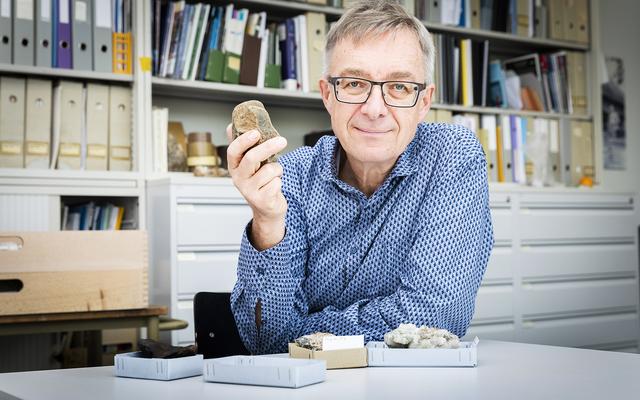In collaboration with the Global Fireball Observatory at Australia's Curtin University, six cameras have been in use since 2021 to observe the night sky in the central desert of Oman. These cameras are used to observe large shooting stars, so-called fireballs, and help to determine the landing site of meteorites. On December 23, 2023, a fireball with a duration of 3.3 seconds was recorded by four cameras. After reconstructing the trajectory and the fall location, an Omani-Swiss field team with the participation of scientists from the Natural History Museum Bern NMBE found the meteorite on February 10, 2024 near an abandoned drilling site called Raja in the Omani province of Al Wusta. It has now been included in the international meteorite database.
Second find of this kind
The meteorite weighs only 26.8 grams and was found 49 days after it fell. The link between the observed fireball and the recovered meteorite was confirmed by the detection of the short-lived radioactive isotopes manganese-54 and sodium-22, which are produced in space. These isotopes were measured using the GeMSE gamma spectrometer at the Vue-des-Alpes deep laboratory in the Neuchâtel Jura. Optical and electron microscopic examination revealed that the meteorite belongs to the rare group of enstatite chondrites. The meteorite also contains a previously unknown mineral. The data was recently submitted to the Meteoritical Society and the meteorite is now officially classified as EH3. The meteorite has been officially named Raja after its fall location.
Raja is the second observed fall recovered in the Sultanate of Oman. This new find of a small meteorite proves that the search conditions in the flat desert areas are excellent and allow the recovery of small meteorites after their observed fall.
From the asteroid belt between Mars and Jupiter
Enstatite chondrites contain minerals that are not stable in the Earth's oxygen- and moisture-rich atmosphere. The rapid recovery from the desert therefore provided valuable, unaltered material for studies. Analysis of Raja's trajectory shows that it originated from the asteroid belt between Mars and Jupiter. Linking orbits and meteorite types helps us to better understand where meteorites come from.
Small meteorites make up the majority of all meteorites that reach Earth, but are rarely recovered because they are difficult to find. Raja is therefore an important contribution to our understanding of the overall flow of meteorites to Earth. The find was made as part of a research project supported by the Swiss National Science Foundation (SNSF), which aims to better understand how often small meteorites fall to Earth.
Institutions involved:
- Ministry of Heritage and Tourism, Sultanate of Oman
- Naturhistorisches Museum Bern
- Musée d’histoire naturelle de la ville de Genève
- Universität Bern
- Curtin University, Perth, Australien
- Albert-Ludwigs-Universität, Freiburg, Deutschland



